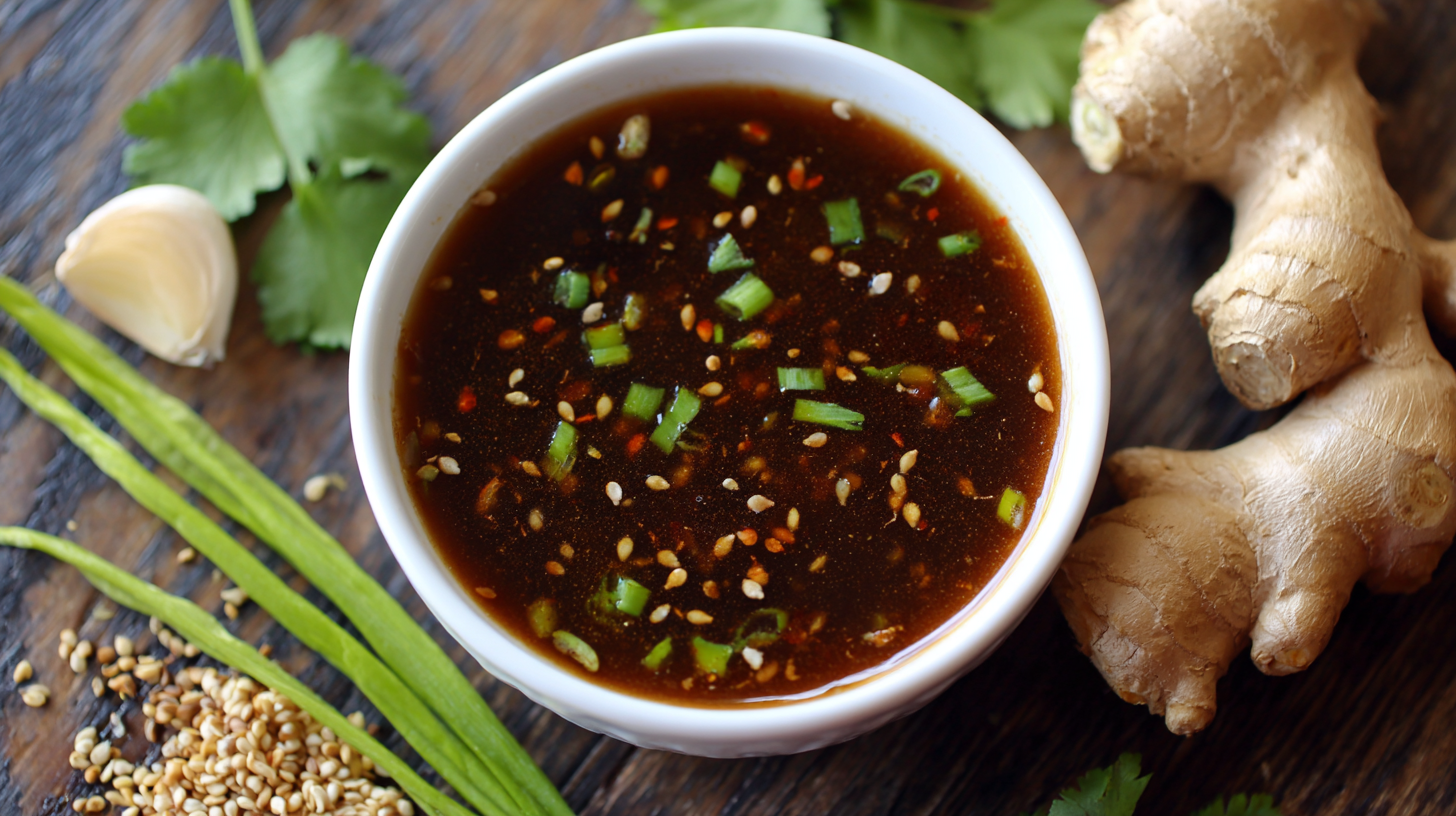Ingredients
You need just a handful of basic ingredients to create this versatile stir fry sauce. Most items are likely already in your pantry or easily found at any grocery store.
Base Sauce Ingredients
- 1/4 cup soy sauce (low sodium preferred)
- 2 tablespoons oyster sauce
- 1 tablespoon cornstarch
- 1 tablespoon brown sugar (packed)
- 2 teaspoons sesame oil
- 2 cloves garlic (minced)
- 1 teaspoon fresh ginger (grated)
- 3 tablespoons chicken broth (or vegetable broth)
- 1 tablespoon rice vinegar
Optional Flavor Enhancers
- 1/2 teaspoon red pepper flakes (for heat)
- 1 tablespoon honey (for extra sweetness)
- 1 teaspoon sriracha (adjust to taste)
- 1 green onion (finely chopped)
- 1 teaspoon black pepper (freshly ground)
- 1/2 teaspoon Chinese five-spice powder
- 1 tablespoon hoisin sauce (for deeper flavor)
Equipment Needed
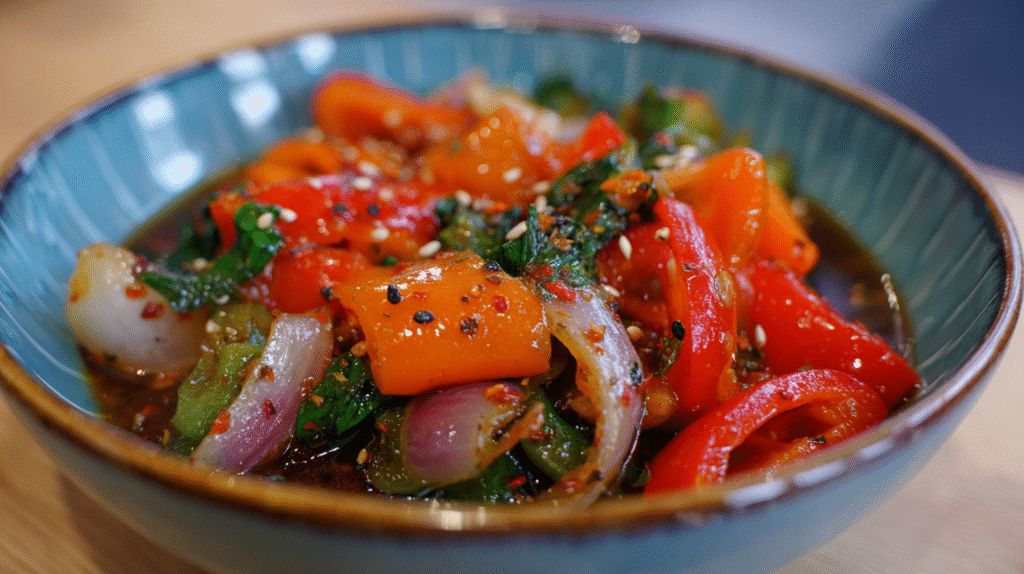
You need just a few basic kitchen tools to create this restaurant-quality stir fry sauce. A medium mixing bowl serves as your primary workspace for combining all the sauce ingredients smoothly. Your trusty whisk becomes essential for dissolving the cornstarch completely and preventing any lumps from forming in the final sauce.
A measuring cup set helps you achieve precise ratios for each ingredient. Small measuring spoons ensure accurate amounts of concentrated flavors like sesame oil and rice vinegar. Keep a fine-mesh strainer nearby if you want to remove any garlic or ginger pieces for an ultra-smooth consistency.
Your stovetop and a small saucepan come into play when you want to thicken the sauce through gentle heating. A wooden spoon or silicone spatula works perfectly for stirring the mixture while it warms. Some cooks prefer using an immersion blender for incorporating fresh garlic and ginger directly into the sauce base.
A clean glass jar or airtight container becomes crucial for storing your homemade sauce. Mason jars work exceptionally well since you can easily see the sauce level and they seal tightly for refrigerator storage. Label makers or masking tape help you track preparation dates.
No specialized equipment or expensive gadgets are required for this simple sauce recipe. Standard kitchen tools that most home cooks already own will produce professional results every time.
Instructions
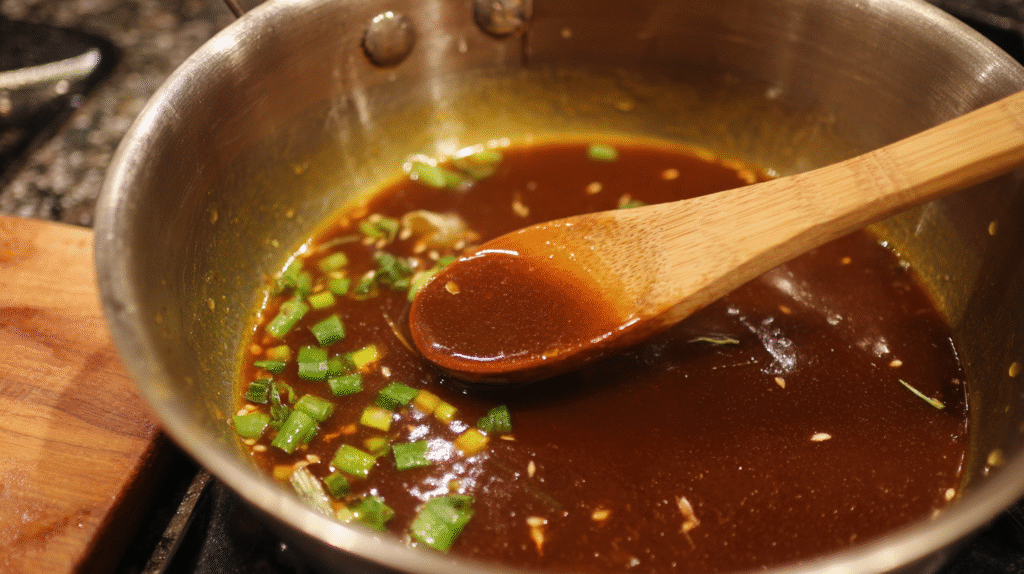
Creating your homemade stir fry sauce requires just a few simple steps that take less than 10 minutes. Follow these straightforward instructions to achieve that glossy restaurant-quality coating every time.
Prep the Ingredients
Gather all your ingredients and measure them accurately before you begin mixing. Mince 3 cloves of fresh garlic and grate 1 tablespoon of fresh ginger using a microplane or fine grater. Set these aromatic ingredients aside in small bowls.
Measure 1/4 cup soy sauce, 2 tablespoons oyster sauce, 1 tablespoon brown sugar, 1 teaspoon sesame oil, 1/4 cup chicken or vegetable broth, and 1 tablespoon rice vinegar into separate containers. Having everything pre-measured ensures smooth sauce preparation without any rushing or missing ingredients.
Place 1 tablespoon cornstarch in a small bowl and set it near your workspace. This thickening agent will create the signature glossy texture that makes stir fry sauce cling perfectly to vegetables and proteins.
Mix the Sauce
Combine the soy sauce, oyster sauce, and brown sugar in your medium mixing bowl. Whisk these base ingredients together until the brown sugar completely dissolves and no granules remain visible.
Add the minced garlic, grated ginger, sesame oil, broth, and rice vinegar to the bowl. Whisk vigorously for 30 seconds to ensure all flavors blend evenly throughout the mixture.
Sprinkle the cornstarch over the liquid ingredients while whisking continuously. Continue whisking for another 60 seconds until the cornstarch fully incorporates and no lumps remain in your sauce base.
Adjust Seasoning to Taste
Taste your sauce using a clean spoon and evaluate the balance of sweet, salty, and savory flavors. Add 1/4 teaspoon red pepper flakes if you prefer heat, or drizzle in 1 teaspoon honey for extra sweetness.
Pour the sauce through your fine-mesh strainer into a clean bowl to remove any remaining lumps or ginger fibers. This step ensures your final sauce has a perfectly smooth consistency.
Store your completed sauce in an airtight glass jar in the refrigerator for up to one week. Give the container a gentle shake before each use, as natural separation may occur during storage.
Directions for Using the Sauce
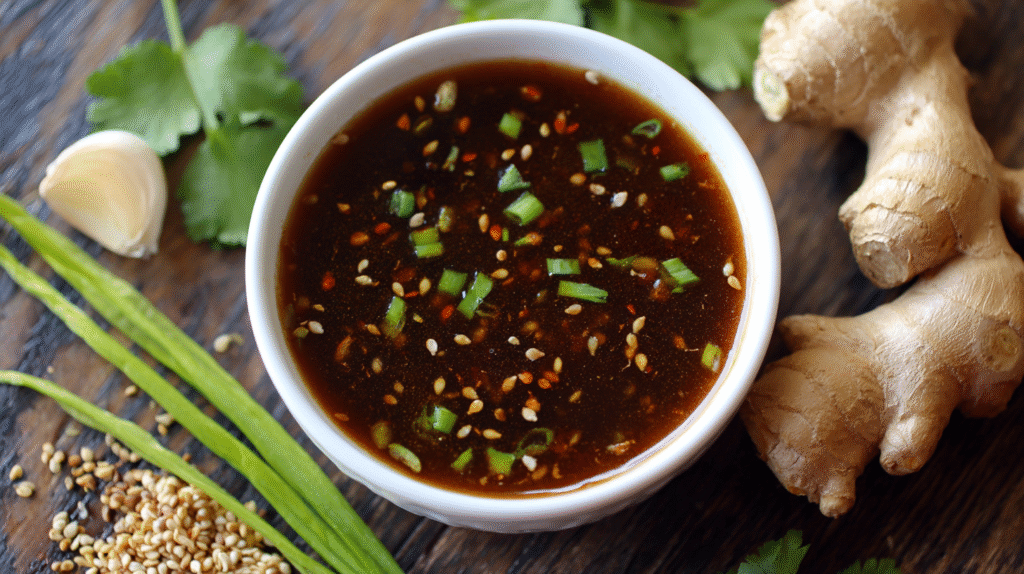
Your homemade stir fry sauce transforms ordinary ingredients into restaurant-quality dishes when used correctly. Mastering the timing and technique ensures your vegetables stay crisp and your proteins develop perfect flavor.
Best Stir Fry Techniques
Heat your wok or large skillet over high heat before adding oil. You need the cooking surface blazing hot to achieve that signature wok hei flavor and prevent ingredients from steaming.
Add oil and swirl to coat the bottom evenly. Your protein goes in first, cooking in a single layer without overcrowding the pan. Let each piece sear for 30-45 seconds before stirring to develop proper browning.
Remove cooked protein to a plate and add harder vegetables like carrots and broccoli stems first. These need more time to reach the perfect tender-crisp texture. Softer vegetables like bell peppers and snow peas follow next.
Keep ingredients moving constantly with a spatula or wooden spoon. This prevents burning and ensures even cooking throughout your stir fry.
Create a well in the center of your vegetables by pushing them to the sides of the pan. This technique allows you to bloom aromatics like fresh garlic and ginger in the hot oil for maximum flavor impact.
When to Add the Sauce
Pour your stir fry sauce into the pan during the final 1-2 minutes of cooking. Adding it too early causes the cornstarch to break down and lose its thickening power.
Give the sauce a quick stir before adding since cornstarch settles at the bottom. The mixture should coat the back of your spoon smoothly without lumps.
Return your cooked protein to the pan immediately after adding the sauce. This allows everything to heat through together while the sauce thickens and creates that glossy coating.
Toss all ingredients continuously for 30-60 seconds until the sauce coats everything evenly. You’ll notice the sauce transforming from thin liquid to a rich glaze that clings to each piece.
Remove the pan from heat as soon as the sauce reaches your desired consistency. Overcooking causes the sauce to become gummy and lose its silky texture.
Storage Instructions
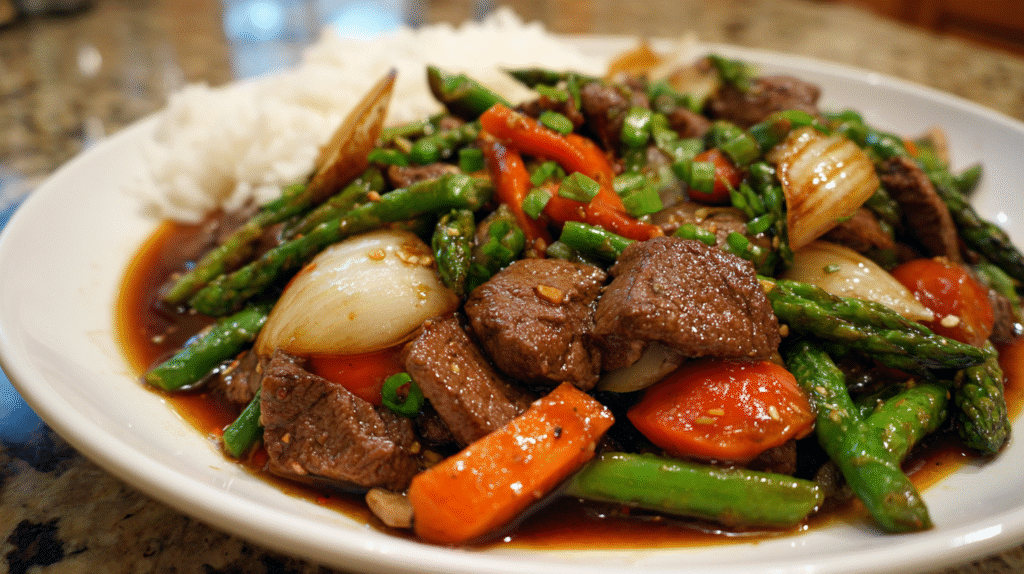
Proper storage keeps your homemade stir fry sauce fresh and flavorful for multiple cooking sessions. Following these storage guidelines ensures you always have restaurant-quality sauce ready for your next meal.
Refrigerator Storage
Store your finished stir fry sauce in a clean glass jar or airtight container in the refrigerator for up to one week. The sauce maintains its best flavor and consistency when kept at temperatures below 40°F.
Always stir the sauce before each use since natural separation occurs during storage. Cornstarch settles to the bottom while oils rise to the surface creating distinct layers.
Check for signs of spoilage before using stored sauce including off odors, mold growth, or changes in color or texture. Fresh garlic and ginger components make the sauce more perishable than commercial versions.
Label your container with the preparation date to track freshness accurately. Glass containers work better than plastic for preventing flavor absorption and maintaining sauce quality over time.
Make-Ahead Tips
Prepare double or triple batches to maximize your cooking efficiency throughout the week. Larger quantities require the same preparation time while providing multiple meals worth of sauce.
Portion the sauce into smaller containers for convenient single-use servings. This approach prevents contamination of the entire batch and allows for easy meal planning.
Store base sauce ingredients separately if you want maximum freshness for extended periods. Mix cornstarch with a small amount of cold broth just before cooking to prevent premature thickening.
Freeze individual portions in ice cube trays for up to three months if you need longer storage options. Thaw frozen sauce cubes in the refrigerator overnight before use and stir thoroughly to restore proper consistency.
Variations
Your basic stir fry sauce recipe serves as the perfect foundation for countless flavor combinations. Transform this versatile base into specialized sauces that match any cuisine preference or dietary requirement.
Spicy Stir Fry Sauce
Add heat to your base recipe by incorporating 1-2 teaspoons of sriracha or chili garlic sauce directly into the mixing bowl. Double the red pepper flakes to 1/2 teaspoon for an extra kick that builds gradually with each bite. Fresh sliced Thai chilies provide authentic heat when you mince 1-2 peppers and whisk them into the sauce mixture.
Adjust the brown sugar to 2 tablespoons to balance the spice level and prevent overwhelming heat. Sesame oil becomes crucial in this variation as it carries the heat throughout the dish while adding nutty richness. Taste your sauce after each addition since spice tolerance varies significantly between individuals.
Store this spicy version for up to 5 days in the refrigerator as the fresh chilies reduce shelf life slightly. The heat intensifies after 24 hours of storage so start with less spice than you think you need.
Sweet and Sour Version
Transform your base sauce into a restaurant-style sweet and sour coating by increasing brown sugar to 3 tablespoons and adding 2 tablespoons of pineapple juice. Rice vinegar gets doubled to 2 tablespoons for the signature tangy bite that defines this classic flavor profile. Tomato paste adds depth when you whisk in 1 tablespoon along with the other ingredients.
Orange juice concentrate provides concentrated citrus flavor without excess liquid when you add 1 teaspoon to the mixture. Honey enhances the sweetness naturally while creating a beautiful glaze that clings perfectly to proteins and vegetables. Bell peppers and pineapple chunks work exceptionally well with this sauce variation.
Cornstarch becomes even more important in this version since the extra sugars need proper thickening to achieve the glossy coating. Increase cornstarch to 2 tablespoons for optimal consistency that won’t become sticky or overly thick.
Garlic Ginger Sauce
Elevate the aromatic components by tripling both fresh garlic and ginger to create an intensely flavorful sauce. Mince 6 cloves of garlic and grate 1 tablespoon of fresh ginger for maximum impact that penetrates every ingredient in your stir fry. Black pepper gets increased to 1/2 teaspoon to complement the warming spices.
Chinese five-spice powder adds complexity when you incorporate 1/2 teaspoon into this variation. Chicken broth works better than vegetable broth in this version as it provides a richer base that supports the bold aromatics. Green onions become essential for finishing this sauce both in the mixture and as garnish.
Sesame oil doubles to 2 teaspoons since it carries the garlic and ginger flavors throughout the dish effectively. This variation pairs exceptionally well with beef and broccoli or any protein that benefits from bold savory flavors. The sauce maintains its one-week refrigerator storage time even though the increased fresh ingredients.
Troubleshooting Tips
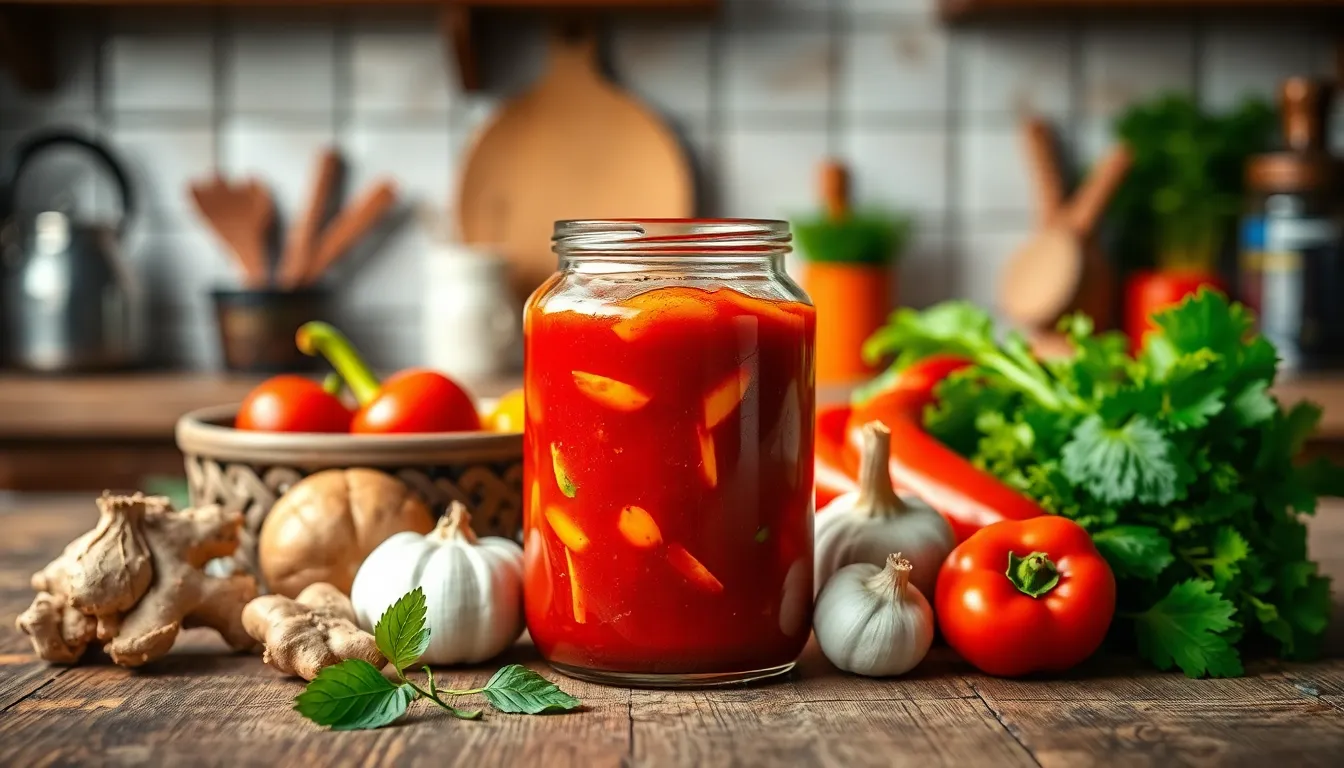
Your sauce turned out too thin even though following the recipe exactly. Mix an additional teaspoon of cornstarch with two tablespoons of cold water to create a slurry. Stir this mixture into your sauce and heat it in a small saucepan over medium heat until it thickens to your desired consistency.
Lumps formed in your sauce during mixing. This happens when cornstarch clumps together with liquid ingredients. Strain your sauce through a fine-mesh strainer to remove any lumps immediately. Pour the smooth sauce back into your container and whisk vigorously to prevent future clumping.
Your stir fry sauce tastes too salty after the first taste test. Balance the saltiness by adding one tablespoon of brown sugar or honey to counteract the sodium levels. You can also dilute the sauce with an extra two tablespoons of chicken broth or rice vinegar to reduce the overall salt concentration.
The sauce appears too thick and sticky when you pour it from the container. Add warm broth one tablespoon at a time until you reach the proper pouring consistency. Cold storage naturally thickens the sauce so this adjustment is completely normal.
Your vegetables turned mushy even though using the recommended cooking technique. The sauce was likely added too early in the cooking process. Remove the pan from heat immediately and serve the dish as is. For your next attempt add the sauce only during the final 1-2 minutes of cooking.
Burnt garlic or ginger pieces created a bitter taste in your final dish. Start over with fresh aromatics and reduce your heat to medium-high instead of high heat. Aromatics should sizzle gently when added to the oil rather than aggressively bubble and brown.
Your sauce separated during storage in the refrigerator. This separation is completely natural due to the oil content. Stir the sauce thoroughly with a whisk before each use to recombine all ingredients. The sauce will return to its original smooth consistency.
The sauce lacks the glossy restaurant-style appearance you expected. Increase your cornstarch by half a teaspoon in your next batch for better thickening power. You can also add an extra teaspoon of sesame oil to enhance the sauce’s natural sheen and rich appearance.
Your stir fry turned out bland even though using the full amount of sauce. Taste your sauce before cooking and adjust the seasonings accordingly. Add more soy sauce for umami depth or increase the ginger and garlic for stronger aromatic impact.
White foam appeared on top of your stored sauce after three days. This indicates the beginning of spoilage and you should discard the entire batch immediately. Make smaller quantities in the future to ensure you use the sauce within its optimal freshness window.
Serving Suggestions
Your homemade stir fry sauce pairs beautifully with countless protein and vegetable combinations to create satisfying meals any night of the week. Transform simple chicken breast into an elegant dinner by cutting it into bite-sized pieces and stir frying with bell peppers, snap peas, and carrots. Beef strips work exceptionally well with broccoli and mushrooms for a classic combination that never disappoints.
Seafood lovers can elevate shrimp or scallops by quickly searing them before adding the sauce and fresh vegetables like zucchini and cherry tomatoes. Tofu provides an excellent plant-based option that absorbs the sauce flavors wonderfully when cubed and lightly browned before combining with bok choy and bean sprouts.
Rice serves as the traditional foundation for stir fry dishes, though you can experiment with different varieties to change the meal’s character. Jasmine rice offers a fragrant base that complements the sauce’s savory notes. Brown rice adds nutty flavor and extra nutrition to your plate. Cauliflower rice creates a low-carb alternative that still soaks up the delicious sauce.
Noodle dishes showcase your sauce in an entirely different way. Lo mein noodles create restaurant-style dishes when tossed with your sauce and favorite vegetables. Rice noodles provide a gluten-free option with excellent sauce absorption. Even spaghetti works in a pinch for fusion-style meals that combine Italian pasta with Asian flavors.
Garnish your finished dishes with sesame seeds for added crunch and visual appeal. Fresh green onions provide a pop of color and mild onion flavor that brightens each bite. Crushed peanuts add texture and richness to vegetable-heavy stir fries. A sprinkle of red pepper flakes gives heat lovers an extra kick.
Consider serving your stir fry alongside complementary dishes to create a complete meal experience. Steamed dumplings make excellent appetizers that pair with the sauce’s savory profile. Fresh spring rolls provide a light contrast to heavier stir fried dishes. Hot and sour soup offers a warming start to your Asian-inspired dinner.
Leftover sauce transforms simple weeknight meals into something special. Drizzle it over grilled vegetables for an instant flavor boost. Use it as a marinade for chicken or pork before grilling or baking. Even scrambled eggs become more interesting with a splash of your homemade stir fry sauce mixed in during cooking.
Conclusion
You’ve now got everything you need to create restaurant-quality stir fry sauce right in your own kitchen. This simple recipe puts you in control of flavors while saving money and eliminating unnecessary additives from store-bought versions.
The beauty of homemade stir fry sauce lies in its adaptability. Whether you prefer extra heat or a sweeter profile you can adjust the ingredients to match your family’s taste preferences perfectly.
Don’t let another weeknight dinner fall flat when you could be creating glossy flavorful dishes that rival your favorite takeout spot. Your kitchen arsenal is now complete with this versatile sauce that transforms ordinary ingredients into extraordinary meals.

